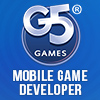The Global Game Jam and beyond series sheds light on the few brave Global Game Jam (GGJ) teams that have decided to take their GGJ projects to the next level and continue development after those challenging 48 hours. We ask each team to tell about their experiences, share learned lessons and offer advise on their attempt to turn their Global Game Jam project into a full fledged commercial product.
Last year’s edition of the Global Game Jam saw its biggest entry of games yet. Combined with the rather obscure theme of Ouroboros, the ancient symbol of a serpent or dragon eating its own tail.
Based on the Oroborus theme for the GGJ2012 the team behind the quirky one-button arcade game Catch-22 wanted to make a game in which your actions bite yourself in the ass. This resulted in them not only winning the local competition at their jam site, but later also won a prize for being the best Dutch Global Game Jam game. Catch-22 also later became one of the PAX 10 selected indie projects to be showcased at the PAX Prime event in Seattle back in August 2012.
Catch-22 has been in development for iOS ever since.
After we finished the game we realized we made a game in which there is no AI entity or anything attacking you in the game, but yourself. Contrary to normal arcade games, Catch-22 doesn’t pump you full of adrenaline with upbeat music and flashy stuff, or send in hordes of enemies towards you to defeat. You do that by yourself, because this game is all about the endless battle you have with yourself. That idea was truly unique and something that we hadn’t seen before ourselves, so we decided to continue developing Catch-22.
What triggered your initial consideration that your game was worth to continue development?
We didn’t have the idea that our game was worth continuing until after the GGJ ended. We only came to insight on what our concept was worth after the Jam, when we won first place in the national Dutch Global Game Jam. During the Jam itself, we were really just focusing on making the game, were exhausted afterwards and just glad we finished it.
Since our game is a one-button game it’s really easy to port it to any platform since you don’t need a controller. We also made it in Unity 3D, which gave us the power to port it to handheld devices (iOS and Android) instantly. So we figured; why not?!

What do you believe was the main element of your game that allowed it to be commercially viable?
After the jam we had a working proof of concept and it only need a lot of polishing. Next to that the game doesn’t require a specific input device such as a controller so it’s easy to port it virtually to any system. And again, Unity 3D gets you a long way.
What really got things in motion was that we got the Dutch “Gamefonds”, a local subsidy for creative projects, to financially support the development of the game just one month after the GGJ. I’ve seen enough projects die young because of the lack of funds, and our project almost suffered the same fate. The funding enabled us to finish the game, fly our butts over to A MAZE IndieConnect, PAX Prime and IndieCade, and hire the necessary artists to work on the game. We simply couldn’t have done it without this initial starting money.

How did you manage the step to go commercial in your team?
We have a really simple way of working which translates to this line; Drink beer, smoke cigarettes and make video games. Rinse and repeat this until the fat lady sings. Really, just flip the switch and go for it, because there is only two ways of doing things; Do them really well, or leave it for someone to do it really well. Because making games is hard, tedious work and you, my friend, are not a robot.

What were the three most important experiences/learned lessons and/or challenges that you had while further developing your game?
First of all, make some solid agreements beforehand. If you do get in a situation where there is a conflict within the team, you can still have a level of conversation where you can clear the air. If you don’t do this, then be prepared for some hard loving from your close friends. For example in our team, team member Roel had spend a lot more time into the project in the beginning stage and wanted to be compensated for it. I agreed, but team member Marlon didn’t and had his own reasons for it. In the end we arranged to have a team leader (aka a neutral party) who overlooked the project and could talk to us as a supervisor. This made all the difference for the balance within the team. So unless you have really, really good agreements, you can’t simply overcome the possible conflicts that arise within your team. There are one too many teams who think they can do without a good agreement, and it just doesn’t work like that in any kind of game development setting.
Second, make a plan to where you want your game and/or company to be in a few months. Make your goals achievable, because just talking about it with your team will not just make it happen by itself. Things change over time and personal situations can get the upper hand if you don’t. I got de-motivated by the fact that things took too long or just simply weren’t done during a certain period of development. Motivation is the only thing that keeps you going when making games, whether it’s money or just finishing your game. So get your mind straight and make sure to get your long-term focus right. Nearing completion, we would regularly go out for drinks and enjoy ourselves from time to time. Having the release of the game within reach, things got a lot less stressful. Most conflicts took place at the beginning of the project. In retrospect, we also stayed motivated by the achievements we got in the meantime; from winning the GGJ to getting 25k honored, to being selected for PAX10 and IndieCade, and finally the release ahead. Having stuff to look forward to is great, especially finishing your game.
In your case, what did you learn from getting the game out to the public?
Start doing this as soon as possible. You will be surprised where it can take you and your game! We can’t stress people enough to do this. If you feel uncomfortable doing this, talk to some people, practice and work on your pitch. Because the public doesn’t see your game like you do and their opinion is the most valuable one you can get. It’s also a really good way to test if your game is commercially viable. If you get some reactions from people who ask you if it’s already for sale or available, Ka-ching! You got game!
What kind of tips would you give to other GGJ participants who might decide to continue developing their project?
Stop crying and making excuses to not release your game or get it out in the open right now. It’s the first sign of failure and I witnessed this in person at the company where I did my traineeship.
It takes time for your game to pick up momentum if you haven’t released any games before or are a well known game developer. Don’t think people will be jumping and begging for your game, because there is a lot of competition out there.
Last but not least, get accustomed to the Nike mentality; just do it! And that goes for everything in your project, from making your game to marketing and PR. Best practices come from experience, and it’s ok to “fail” on your first go.
Cath-22 for iOS can be downloaded in the AppStore.

Comments









